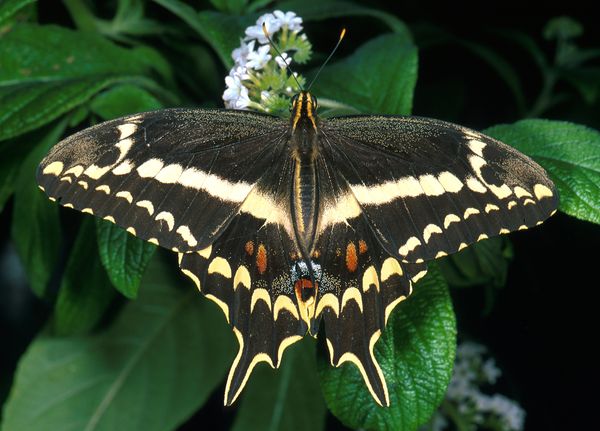Hope for Endangered Butterfly Species
Researchers are working to save the Schaus swallowtail, a species of butterfly that was declared endangered in 1984.
You can find the Schaus swallowtail butterfly on a U.S. postage stamp. But you'd have a harder time finding it in the wild.
The brown-and-yellow insect, which graced a stamp in 1996 to reflect its endangered status, has been hard to locate lately.
Sightings of the Schaus have fluctuated dramatically over the past 20 years, from the hundreds to the dozens. In recent years, habitat loss, drought, and pesticides have contributed to a precipitous drop in sightings, from 41 in 2011 to four in 2012.
Currently, the butterfly is believed to live only in a small patch of forest called tropical hardwood hammock, dense with evergreens and ferns, on Elliot Key in the Florida Keys. The U.S. Fish and Wildlife Service listed the Schaus as endangered in 1984.
Now the butterfly's odds of survival are improving, thanks to researchers from the University of Florida, the National Park Service, the Florida Fish and Wildlife Conservation Commission, the U.S. Fish and Wildlife Service, and the North American Butterfly Association.
This spring, the researchers collected seven larvae and more than a hundred eggs to store for breeding the Schaus next year. Collecting eggs is critical—the Schaus, unlike other butterflies, lays eggs only once a year, which makes it harder for the species to rebound.
The eggs and larvae are being stored in the lab of Jaret Daniels, an assistant professor in the University of Florida's Department of Entomology and Nematology, and an associate curator of lepidoptera (moths and butterflies) for the university's Florida Museum of Natural History. Daniels hopes to raise the larvae and eggs to maturity in his lab, then breed more Schaus butterflies to bolster the population.
But no one expects a huge turnaround. The butterfly habitat isn't large enough to support more than about one thousand, said Mark Salvato, a fish and wildlife biologist for the U.S. Fish and Wildlife Service.
The Schaus is one of the larger breeds of butterfly, about the length of a ballpoint pen. It prefers to move around in a dense, closed canopy. By contrast, most butterflies flutter in the open air of parks and backyards.
Despite the cramped quarters of its usual habitat, the Schaus is adept at maneuvering, even flying backward at times, which is not characteristic of most other swallowtails, Daniels said.
"It's a very large and showy, very handsome butterfly," Daniels said. "It has kind of, by default, become an icon for the tropical hardwood hammock habitat."
Harmony Huskinson
National Geographic News
Published June 11, 2013












